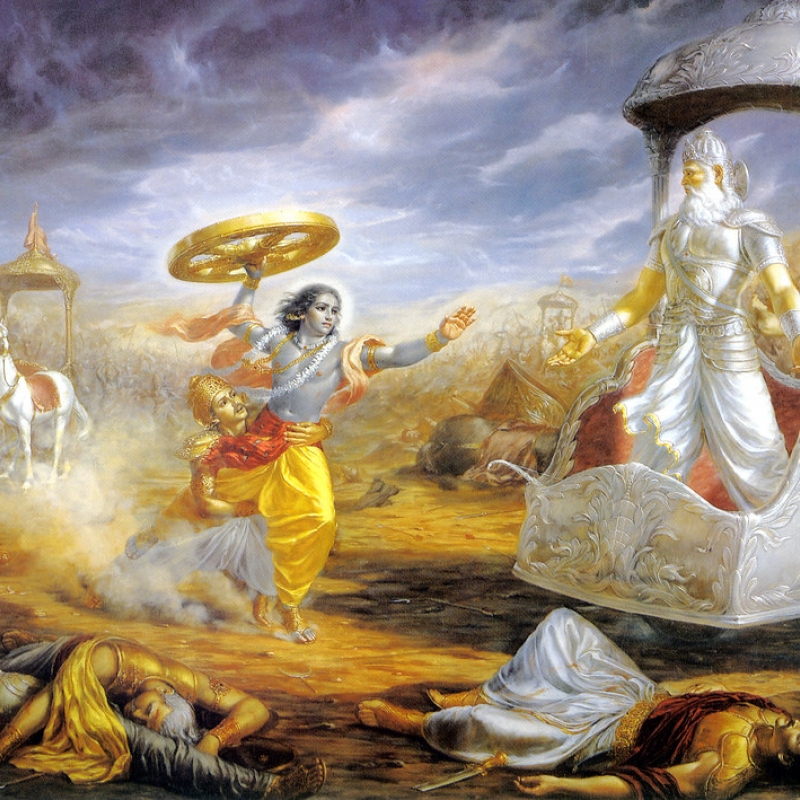Dalpat Chauhan is one of the major architects of Dalit literature in Gujarati. He has written poetry, plays, novels, short stories and critical essays to voice his commitment towards the Dalit and Adivasi community, and his writings have often been an expression of the grief and oppression that these communities have historically faced. Two of his plays, Anaaryavart and Antim Dhyey, particularly show how Chauhan is consciously involved in iconoclasm and rewriting mythology.
Both these plays are collected in an anthology of three plays titled Anaaryavart[1]; they take the ancient Indian epic Mahabharata as their source and pretext. In the preface to Anaaryavart, Chauhan writes:
Mahabharata is the story of the annihilation of millions of lives. But where is the common person in it? Which poet has really heard the screams of a dead common soldier’s wife, mother, children or parents? Who would express the feelings of Dasa, Dasyu, Gulam, Dhimar, Machhuaara, Naaga, Hidamb, Takshak[2] and other tribes in Mahabaharata?[3]
Chauhan takes this task upon himself and imagines Anaaryavart as a peaceful empire, independent of the Aaryans, which consists of all the commoners, ‘lower caste’ communities and tribes who are in complete harmony with nature. This could be seen in opposition to Aaryavart, the empire of the ‘upper castes’ and the royal blood coloured with war and territory expansion. Chauhan’s creativity lies in making Krishna Dvaipayan Vyasa, the celebrated creator of Mahabharata who is more popularly known as Ved Vyasa, the chief protagonist of the play. In the mainstream version of Mahabharata, too, Vyasa enters the narrative as a character and helps in furthering the line of Aaryans because Bhishma takes a vow of celibacy. In that sense, Vyasa is the creator of Aaryavart and the narrator of their story. Chauhan, however, takes a different approach. Sanjay Shripad Bhave, renowned sociologist and scholar based out of Gujarat, elucidates: ‘The playwright’s true vision is that he makes Vyasa the dreamer of Anaaryavart and not the creator of Aaryavart.’[4] Chauhan’s characterisation of Vyasa also makes sense because Vyasa belongs to the Anaaryas, and is only a half-brother to Bhishma as Vyasa’s mother Satyavati is married to Bhishma’s father Shantanu.
The central conflict of the play is between Vyasa and Bhishma. Vyasa becomes the champion of the Anaaryas and goes as a messenger to Bhishma to ask for the independence of the Anaaryas from the Aaryavart. However, he is captured by Bhishma and is forced to perform niyoga (an ancient Indian practice where a man is delegated to help a woman bear child when her husband is dead or incapable of fatherhood) with the widows of Vichitravirya, Bhishma’s half-brother and heir to the throne of Hastinapur. It is in prison that Vyasa gets a chance to have a conversation with his mother Satyavati. He tries to convince her to help him free the Anaaryas from Aaryavart as she is also originally an Anaarya. The play ends when Satyavati finally chooses to go with Vyasa to Anaaryavart to fight for their independence. The most interesting bit in the play is the conversation between Vyasa and Bhishma; it is here that we hear the voice of the playwright and get a glimpse into his perspective.
Vyasa: You do not want a direct heir to the throne, do you?
Bhishma: Why do you say that?
Vyasa: Calling me, an outsider, to have niyoga with these widows…why would you not do it yourself?
Bhishma: Because I am Bhishma. I have taken a vow of celibacy, and I am committed to following it, no matter what.
Vyasa: You are not committed, Bhishma! You are afraid, you are a coward. Because what happens if you have children? Amba and Ambalika would fight for you, there will be a war in the household itself… and you would be a spectator to it!
Bhishma: I am stopping myself from killing you only because you are my half-brother…
Vyasa: […] I know you need me […] I am your half-brother. You want your ancestry vine to grow in your own shade, and I understand that.
Bhishma: You are crossing limits now, Dvaipayan!
Vyasa: And you crossed it long back! All these are pawns of your game—Satyavati, the widows, and me too. I want a free Anaaryavart, while you are concerned about the great Aaryavart, and you want Aaryavart to continue to be great the way you wish![5]
(Translation by the author)
This entire conversation takes a dig at Bhishma. In the mainstream and popular culture, Bhishma is lauded for the virtuosity and bravery and is, at times, even worshipped for his vow of celibacy which is seen as a grand sacrifice he made for the sake of his father’s happiness. A great warrior, and the grandfather of the Kauravas and Pandavas, Bhishma was also granted the boon of choosing the time of his death. The conversation above provides us with a very different idea of Bhishma: a shrewd administrator and a selfish man with a desire to achieve greatness by manipulating and using other people to achieve his ends. This kind of a portrayal of Bhishma is rare in literature and popular culture; instead of being seen as a hero, what we see here is a different, previously untouched side of Bhishma, the champion of the Aaryans.
This iconoclastic trait is visible also in Chauhan’s play Antim Dhyey. The structure and themes are similar, but the conflict is more personalised. The protagonist of the play is Eklavya’s son Jara, and the chief antagonist is none other than Lord Krishna. While partially basing it on the events of Mahabharata, Chauhan significantly departs from it in that he takes the story of Eklavya forward. Mahabharata only features Eklavya’s death, but Chauhan imagines Eklavya’s life beyond the epic and integrates the legend of the death of Lord Krishna into his play. As the legend goes, Krishna was killed by an arrow of a hunter called Jara in a forest while he was resting under a tree. Chauhan imagines Jara to be Eklavya’s son and weaves a story of personal revenge and common good for the Anaaryas that required Krishna’s death owing to the enormous harm he caused them to uplift Aaryavart: to note just one instance amongst many, his role in the burning of the Khandava forest that was home to several Anaaryas. Pandavas needed to burn the forest to create their modernised city called Indraprastha, and Krishna helped them achieve that. Antim Dhyey begins with Jara, his sister Yaku, and other Anaaryas plotting Krishna’s death, and ends with Jara succeeding in his plan.
Like Anaaryavart’s confrontation between Vyasa and Bhishma, Antim Dhyey too features a conversation between Jara and Krishna right before Krishna’s death, which is revealing of the playwright’s perspective.
Jara: It is me. Eklavya’s son Jara.
Krishna: Who Eklavya? Oh yes, the tribal prince. I remember. You are his son. He died in a battle with me.
Jara: No no…
Krishna: What do you mean?
Jara: He did not die, Krishna, you killed him by cheating. You broke the rules of war. You killed him with this wheel […] You made this new weapon for war […] and never taught anyone to use it, right?
Krishna: Yes, because I did not want this weapon to bring the downfall of humanity.
Jara: Do not lie. You wanted to remain undefeated because of this weapon. That is why you never taught anyone how to use it. Other people sold their weapons and their knowledge about them. But you just piled up your knowledge […] what else you have caused but destruction! Especially for our Anaarya communities […]
Krishna: Destruction and development go hand in hand. Whoever understands this, wins. That was the call for development. Your people could not match their rhythms with it.
Jara: So, you destroyed them? Their only fault was to defend their culture against yours, right?
Krishna: That is not enough, Jara! I wanted the entire humanity to develop! Everyone develops—that was my only motivation.
Jara: Again, a lie! The collective development, eh? By destroying us? But you destroyed the whole of humanity by destroying us. All of the culture by destroying our culture. Your ideas of truths and lies have coloured this soil with blood.[6]
(Translation by the author)
The conversation between Jara and Krishna echoes the conversation between Bhishma and Vyasa in many respects; it questions and charges the long-lauded heroes for their wrongdoings. The conversation in both cases is driven by an Anaarya and is strongly rooted in caste oppression and personal vengeance. Here, Krishna must confront his sins and face the truth. Jara is not a Pandava who would swallow all the injustices done by Krishna and still worship him.
With the rise of majoritarian Hindu sentiments in India, Rama and Krishna are widely celebrated figures and one can see their iconography everywhere. Krishna is celebrated for several reasons, including his ability to woo women, his all-knowing charm, his decision to side with the Pandavas who were fighting for ‘dharma’ and so on. Krishna’s spectral presence has been haunting India for centuries in different avatars. In the Gujarati literary scenario, several popular authors make a living by writing about the greatness of Krishna. It is understandable if they turn a blind eye to Krishna’s shortcomings as it is after all a question of survival for them. Chauhan’s portrayal of Krishna, on the other hand, is extremely bold and critical, and much needed in such an atmosphere.
Dr Bhavika Parekh, a theatre scholar from Gujarat who worked on the portrayal of Krishna in Gujarati drama, notes in her thesis, ‘The mainstream has portrayed Krishna as Jashodanandan (Jashoda’s child), Gopikavallabh (the lord of the rural women or Gopis) or Yugnayaka (hero of an entire age). It was only in the 17th century that Gujarati poet Premanand had portrayed Krishna as a villain in his epic poem ‘Abhimanyu-Akhyan.’[7] Bhave, too, provides a genealogy of writers who were critical of Krishna, which includes Dr B.R. Ambedkar, Iravati Karve and Anila Dalal.[8] Chauhan is also a part of that list of authors who questioned the flawless divinity of Krishna. Chauhan’s plays provide a different perspective in a political situation where Krishna and his particular characteristics are revered. Both Anaaryavart and Antim Dhyey provide a ‘view from below’, a subaltern view, and are in dire need of a full-fledged production.
Notes
[1] Chauhan, Anaaryavart.
[2] Ancient Indian tribes who suffered due to the Aaryan expansion of territories and their destruction of forests to build cities.
[3] Ibid, 5.
[4] Bhave, Aarya-Anaarya Prashna Nu Anokhu Aalekhan.
[5] Chauhan, Anaaryavart, 13.
[6] Ibid., 55.
[7] Parekh, ‘A Study of Characterization of Sri Krishna in Modern Gujarati Plays.’
[8] Bhave, ‘Sri Krishna na Mithak nu Moortibhanjak Nirupan.’
Bibliography
Bhave, Sanjay Shripad. 'Anaaryavart: Aarya-Anaarya Prashna Nu Anokhu Aalekhan.' Dalit Adhikaar, Ahmedabad, November 16, 2017: 4–6.
———. 'Antim Dhyey: Sri Krishna na Mithak nu Moortibhanjak Nirupan.' Dalit Adhikaar, Ahmedabad, December 1, 2017: 4–6.
Chauhan, Dalpat. Anaaryavart. Ahmedabad: Gujarati Dalit Sahitya Academy, 2012.
Parekh, Bhavika. 'A Study of Characterization of Sri Krishna in Modern Gujarati Plays.' Ph.D. thesis, Department of Gujarati, Sardar Patel University, 2005.













